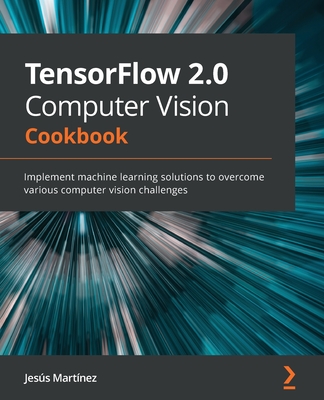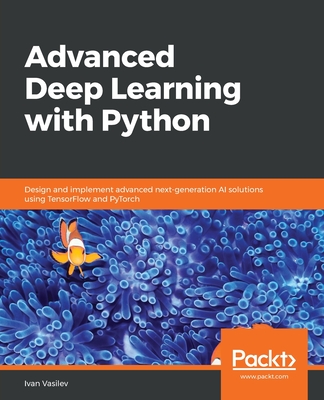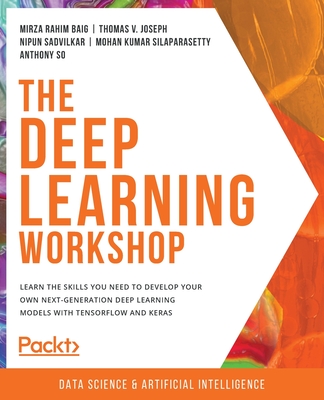TensorFlow 2.0 Computer Vision Cookbook: Implement machine learning solutions to overcome various computer vision challenges (Paperback)
暫譯: TensorFlow 2.0 電腦視覺食譜:實作機器學習解決方案以克服各種電腦視覺挑戰 (平裝本)
Martínez, Jesús
- 出版商: Packt Publishing
- 出版日期: 2021-02-26
- 售價: $1,660
- 貴賓價: 9.5 折 $1,577
- 語言: 英文
- 頁數: 542
- 裝訂: Quality Paper - also called trade paper
- ISBN: 183882913X
- ISBN-13: 9781838829131
-
相關分類:
Computer Vision、TensorFlow
海外代購書籍(需單獨結帳)
買這商品的人也買了...
-
 Python 專家實踐指南|搭乘專業開發者的學習便車 (The Hitchhiker's Guide to Python: Best Practices for Development)
Python 專家實踐指南|搭乘專業開發者的學習便車 (The Hitchhiker's Guide to Python: Best Practices for Development)$580$458 -
 $469Processing 編程學習指南(原書第2版)
$469Processing 編程學習指南(原書第2版) -
 深入理解 Android 內核設計思想, 2/e (上下冊)
深入理解 Android 內核設計思想, 2/e (上下冊)$948$901 -
 奔跑吧!Linux kernel|Linux 4.x kernel 關鍵與原始程式碼解析
奔跑吧!Linux kernel|Linux 4.x kernel 關鍵與原始程式碼解析$880$695 -
 $714Effective Java, 3/e (簡體中文版)
$714Effective Java, 3/e (簡體中文版) -
 科班出身的 AI人必修課:OpenCV 影像處理 使用 Python
科班出身的 AI人必修課:OpenCV 影像處理 使用 Python$780$616 -
 TypeScript 程式設計 (Programming TypeScript)
TypeScript 程式設計 (Programming TypeScript)$580$458 -
 tf.keras 技術者們必讀!深度學習攻略手冊
tf.keras 技術者們必讀!深度學習攻略手冊$1,000$850 -
 PyTorch Computer Vision Cookbook
PyTorch Computer Vision Cookbook$1,690$1,606 -
 Effective TypeScript 中文版|提昇 TypeScript 技術的 62個具體作法 (Effective TypeScript)
Effective TypeScript 中文版|提昇 TypeScript 技術的 62個具體作法 (Effective TypeScript)$580$458 -
 高品質軟體文件|持續分享技術與知識 (Living Documentation: Continuous Knowledge Sharing by Design)
高品質軟體文件|持續分享技術與知識 (Living Documentation: Continuous Knowledge Sharing by Design)$680$537 -
 TinyML|TensorFlow Lite 機器學習 : 應用 Arduino 與低耗電微控制器 (Tinyml: Machine Learning with Tensorflow Lite on Arduino and Ultra-Low-Power Microcontrollers)
TinyML|TensorFlow Lite 機器學習 : 應用 Arduino 與低耗電微控制器 (Tinyml: Machine Learning with Tensorflow Lite on Arduino and Ultra-Low-Power Microcontrollers)$880$695 -
 架構模式|使用 Python (Architecture Patterns with Python: Enabling Test-Driven Development, Domain-Driven Design, and Event-Driven Microservices)
架構模式|使用 Python (Architecture Patterns with Python: Enabling Test-Driven Development, Domain-Driven Design, and Event-Driven Microservices)$680$537 -
 Python 自動化的樂趣|搞定重複瑣碎&單調無聊的工作, 2/e (Automate the Boring Stuff with Python : Practical Programming for Total Beginners, 2/e)
Python 自動化的樂趣|搞定重複瑣碎&單調無聊的工作, 2/e (Automate the Boring Stuff with Python : Practical Programming for Total Beginners, 2/e)$680$537 -
 強化式學習:打造最強 AlphaZero 通用演算法
強化式學習:打造最強 AlphaZero 通用演算法$780$663 -
 $1,680Practical Deep Learning: A Python-Based Introduction
$1,680Practical Deep Learning: A Python-Based Introduction -
 $454深度學習理論與實戰 — PyTorch 案例詳解
$454深度學習理論與實戰 — PyTorch 案例詳解 -
 必學!Python 資料科學‧機器學習最強套件 - NumPy、Pandas、Matplotlib、OpenCV、scikit-learn、tf.Keras
必學!Python 資料科學‧機器學習最強套件 - NumPy、Pandas、Matplotlib、OpenCV、scikit-learn、tf.Keras$680$537 -
 Developing Graphics Frameworks with Python and OpenGL (Hardcove)
Developing Graphics Frameworks with Python and OpenGL (Hardcove)$4,200$3,990 -
 $2,592Practical Machine Learning for Computer Vision: End-To-End Machine Learning for Images (Paperback)
$2,592Practical Machine Learning for Computer Vision: End-To-End Machine Learning for Images (Paperback) -
 Optimizing Visual Studio Code for Python Development: Developing More Efficient and Effective Programs in Python
Optimizing Visual Studio Code for Python Development: Developing More Efficient and Effective Programs in Python$2,350$2,233 -
 數位與醫學的人工智慧影像處理技術:Python 實務
數位與醫學的人工智慧影像處理技術:Python 實務$580$452 -
 Learn Three.js : Program 3D animations and visualizations for the web with JavaScript and WebGL, 4/e (Paperback)
Learn Three.js : Program 3D animations and visualizations for the web with JavaScript and WebGL, 4/e (Paperback)$1,950$1,853 -
 ChatGPT-4 與 Bing Chat - 創新體驗文字/繪圖/音樂/動畫/影片的AI世界
ChatGPT-4 與 Bing Chat - 創新體驗文字/繪圖/音樂/動畫/影片的AI世界$520$411 -
 最強 AI 投資分析:打造自己的股市顧問機器人,股票趨勢分析×年報解讀×選股推薦×風險管理
最強 AI 投資分析:打造自己的股市顧問機器人,股票趨勢分析×年報解讀×選股推薦×風險管理$750$593
相關主題
商品描述
Get well versed with state-of-the-art techniques to tailor training processes and boost the performance of computer vision models using machine learning and deep learning techniques
Key Features
- Develop, train, and use deep learning algorithms for computer vision tasks using TensorFlow 2.x
- Discover practical recipes to overcome various challenges faced while building computer vision models
- Enable machines to gain a human level understanding to recognize and analyze digital images and videos
Book Description
Computer vision is a scientific field that enables machines to identify and process digital images and videos. This book focuses on independent recipes to help you perform various computer vision tasks using TensorFlow.
The book begins by taking you through the basics of deep learning for computer vision, along with covering TensorFlow 2.x's key features, such as the Keras and tf.data.Dataset APIs. You'll then learn about the ins and outs of common computer vision tasks, such as image classification, transfer learning, image enhancing and styling, and object detection. The book also covers autoencoders in domains such as inverse image search indexes and image denoising, while offering insights into various architectures used in the recipes, such as convolutional neural networks (CNNs), region-based CNNs (R-CNNs), VGGNet, and You Only Look Once (YOLO).
Moving on, you'll discover tips and tricks to solve any problems faced while building various computer vision applications. Finally, you'll delve into more advanced topics such as Generative Adversarial Networks (GANs), video processing, and AutoML, concluding with a section focused on techniques to help you boost the performance of your networks.
By the end of this TensorFlow book, you'll be able to confidently tackle a wide range of computer vision problems using TensorFlow 2.x.
What you will learn
- Understand how to detect objects using state-of-the-art models such as YOLOv3
- Use AutoML to predict gender and age from images
- Segment images using different approaches such as FCNs and generative models
- Learn how to improve your network's performance using rank-N accuracy, label smoothing, and test time augmentation
- Enable machines to recognize people's emotions in videos and real-time streams
- Access and reuse advanced TensorFlow Hub models to perform image classification and object detection
- Generate captions for images using CNNs and RNNs
Who this book is for
This book is for computer vision developers and engineers, as well as deep learning practitioners looking for go-to solutions to various problems that commonly arise in computer vision. You will discover how to employ modern machine learning (ML) techniques and deep learning architectures to perform a plethora of computer vision tasks. Basic knowledge of Python programming and computer vision is required.
- Getting Started with TensorFlow 2.x for Computer Vision
- Performing Image Classification
- Harnessing the Power of Pre-Trained Networks with Transfer Learning
- Enhancing and Styling Images with DeepDream, Neural Style Transfer, and Image Super-Resolution
- Reducing Noise with Autoencoders
- Generative Models and Adversarial Attacks
- Captioning Images with CNNs and RNNs
- Fine-Grained Understanding of Images through Segmentation
- Localizing Elements in Images with Object Detection
- Applying the Power of Deep Learning to Videos
- Streamlining Network Implementation with AutoML
- Boosting Performance
商品描述(中文翻譯)
熟悉最先進的技術,以調整訓練過程並提升計算機視覺模型的性能,使用機器學習和深度學習技術
主要特點
- 使用 TensorFlow 2.x 開發、訓練和應用深度學習算法以解決計算機視覺任務
- 發現實用的配方,以克服在構建計算機視覺模型時面臨的各種挑戰
- 使機器獲得人類級別的理解,以識別和分析數位圖像和視頻
書籍描述
計算機視覺是一個科學領域,使機器能夠識別和處理數位圖像和視頻。本書專注於獨立的配方,幫助您使用 TensorFlow 執行各種計算機視覺任務。
本書首先帶您了解計算機視覺的深度學習基礎,並涵蓋 TensorFlow 2.x 的關鍵特性,例如 Keras 和 tf.data.Dataset API。接著,您將學習常見計算機視覺任務的細節,例如圖像分類、遷移學習、圖像增強和風格化,以及物體檢測。本書還涵蓋了自編碼器在逆向圖像搜索索引和圖像去噪等領域的應用,同時提供有關配方中使用的各種架構的見解,例如卷積神經網絡 (CNNs)、基於區域的 CNN (R-CNNs)、VGGNet 和 You Only Look Once (YOLO)。
接下來,您將發現解決構建各種計算機視覺應用時遇到的問題的技巧和竅門。最後,您將深入探討更高級的主題,例如生成對抗網絡 (GANs)、視頻處理和 AutoML,並以一個專注於提升網絡性能的技術部分作結。
在本書結束時,您將能夠自信地使用 TensorFlow 2.x 解決各種計算機視覺問題。
您將學到什麼
- 了解如何使用最先進的模型(如 YOLOv3)檢測物體
- 使用 AutoML 從圖像中預測性別和年齡
- 使用不同的方法(如 FCNs 和生成模型)對圖像進行分割
- 學習如何使用排名-N 準確度、標籤平滑和測試時間增強來提高網絡性能
- 使機器能夠識別視頻和實時流中的人類情感
- 訪問和重用先進的 TensorFlow Hub 模型以執行圖像分類和物體檢測
- 使用 CNNs 和 RNNs 為圖像生成標題
本書適合誰
本書適合計算機視覺開發人員和工程師,以及尋找解決計算機視覺中常見問題的深度學習實踐者。您將發現如何運用現代機器學習 (ML) 技術和深度學習架構來執行各種計算機視覺任務。需要具備 Python 編程和計算機視覺的基本知識。
- 開始使用 TensorFlow 2.x 進行計算機視覺
- 執行圖像分類
- 利用預訓練網絡的力量進行遷移學習
- 使用 DeepDream、神經風格轉換和圖像超解析度增強和風格化圖像
- 使用自編碼器減少噪聲
- 生成模型和對抗攻擊
- 使用 CNNs 和 RNNs 為圖像添加標題
- 通過分割深入理解圖像
- 使用物體檢測定位圖像中的元素
- 將深度學習的力量應用於視頻
- 使用 AutoML 簡化網絡實現
- 提升性能
作者簡介
Jesús Martínez is the founder of the computer vision e-learning site DataSmarts. He is a computer vision expert and has worked on a wide range of projects in the field, such as a piece of people-counting software fed with images coming from an RGB camera and a depth sensor, using OpenCV and TensorFlow. He developed a self-driving car in a simulation, using a convolutional neural network created with TensorFlow, that worked solely with visual inputs. Also, he implemented a pipeline that uses several advanced computer vision techniques to track lane lines on the road, as well as providing extra information such as curvature degree.
作者簡介(中文翻譯)
Jesús Martínez 是電腦視覺電子學習網站 DataSmarts 的創辦人。他是一位電腦視覺專家,曾參與多個領域的專案,例如一款利用 RGB 相機和深度感測器影像進行人數計算的軟體,並使用 OpenCV 和 TensorFlow。他在模擬環境中開發了一輛自駕車,該車僅依賴視覺輸入,並使用 TensorFlow 創建的卷積神經網路。此外,他實現了一個管道,利用多種先進的電腦視覺技術來追蹤道路上的車道線,並提供額外資訊,例如曲率程度。
目錄大綱
- Getting Started with TensorFlow 2.x for Computer Vision
- Performing Image Classification
- Harnessing the Power of Pre-Trained Networks with Transfer Learning
- Enhancing and Styling Images with DeepDream, Neural Style Transfer, and Image Super-Resolution
- Reducing Noise with Autoencoders
- Generative Models and Adversarial Attacks
- Captioning Images with CNNs and RNNs
- Fine-Grained Understanding of Images through Segmentation
- Localizing Elements in Images with Object Detection
- Applying the Power of Deep Learning to Videos
- Streamlining Network Implementation with AutoML
- Boosting Performance
目錄大綱(中文翻譯)
- Getting Started with TensorFlow 2.x for Computer Vision
- Performing Image Classification
- Harnessing the Power of Pre-Trained Networks with Transfer Learning
- Enhancing and Styling Images with DeepDream, Neural Style Transfer, and Image Super-Resolution
- Reducing Noise with Autoencoders
- Generative Models and Adversarial Attacks
- Captioning Images with CNNs and RNNs
- Fine-Grained Understanding of Images through Segmentation
- Localizing Elements in Images with Object Detection
- Applying the Power of Deep Learning to Videos
- Streamlining Network Implementation with AutoML
- Boosting Performance










